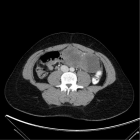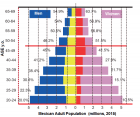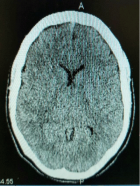Abstract
Research Article
Male Linear Anthropometrics of Selected Nigerian Ethnicities: A Cross - Sectional Analysis
Michael Okon*, HB Fawehinmi, LE Oghenemavwe, PD Okoh, LK David, CA Oparaocha, CE Ebieto, TA James, AN Maryam and TK Adenowo
Published: 23 October, 2024 | Volume 8 - Issue 1 | Pages: 064-070
Introduction: This study aims at evaluating selected linear anthropometrics of three Nigerian ethnic groups to provide baseline data for the creation of 3D Negroid anatomic models.
Methods: The research design was a cross-sectional design. The sampling technique was multistage proportionate random sampling. The places of study were Imo, Oyo, and Kano States of Nigeria. The study lasted for one (1) year. Random selection of 1500 adult males from three major tribes (500 Igbo, 500 Yoruba, and 500 Hausa between the ages of 18 and 40 years). Tukey’s Post Hoc test of multiple comparisons was carried out to determine the specific ethnic groups that differ in specific anthropometric parameters.
Results: The differences in standing height, arm length, and thigh length across the Hausa, Igbo, and Yoruba ethnic groups are statistically significant (p < 0.05).
Conclusion: The study concluded that the Igbo and Yoruba groups had higher standing heights compared to the Hausa group. Arm length was longer in the Igbo and Yoruba groups compared to the Hausa group. However, thigh length was greater in the Hausa group compared to both the Igbo and Yoruba groups, while the Hausa group had longer thigh lengths than both the Igbo and Yoruba groups. The Igbo group displayed the largest arm span, whereas the Hausa group had the widest shoulder breadth. However, the Hausa group had a lower bi-iliac breadth in comparison to the other two ethnic groups.
Read Full Article HTML DOI: 10.29328/journal.jfsr.1001066 Cite this Article Read Full Article PDF
Keywords:
Nigeria; Igbo; Yoruba; Hausa; Anthropometry; Linear measurements
References
- Igbigbi PS, Ominde BS, Adibeli CF. Anthropometric dimensions of hand and foot as predictors of stature: a study of two ethnic groups in Nigeria. Alexandria J Med. 2018;54(4):611-7. Available from: http://dx.doi.org/10.1016/j.ajme.2018.11.002
- Moorthy TN, Mostapa AMB, Boominathan R, Raman N. Stature estimation from footprint measurements in Indian Tamils by regression analysis. Egyptian J Forensic Sci. 2014;4:7-16. Available from: https://doi.org/10.1016/j.ejfs.2013.10.002
- Soo-Chan K, Sanghyun H, Myung. Analysis of stature prediction from foot anthropometry: a South Korean case study. Aust J Forensic Sci. 2015;49:1-8. Available from: https://doi.org/10.1080/00450618.2015.1115127
- Magee J, Winder RJ, McClelland B. Three-dimensional digital modelling of human spine anthropometrics and kinematics from meta-analysis: how relevant is existing anatomical research? J Spine. 2015;4(1):1-7. Available from: https://doi.org/10.4172/2165-7939.1000205
- Paramasivam V, Singh G, Santhanakrishnan S. 3D printing of human anatomical models for preoperative surgical planning. Procedia Manuf. 2020;48:684-90. Available from: http://dx.doi.org/10.1016/j.promfg.2020.05.100
- Von Cramon-Taubadel N. Evolutionary insights into global patterns of human cranial diversity: population history, climatic and dietary effects. J Anthropol Sci. 2014;92(4):43-77. Available from: https://doi.org/10.4436/jass.91010
- Ahmed AA. Estimation of stature from the upper limb measurements of Sudanese adults. Forensic Sci Int. 2013;228(1-3):178-e1. Available from: https://doi.org/10.1016/j.forsciint.2013.03.008
- Ahmad N, Mohammad F, Farooque I. Estimation of height from the long bones of the upper limb and hand dimensions in South Indian population. J Evid Based Med Health Care. 2014;1(7):473-8. Available from: https://www.jebmh.com/articles/estimation-of-height-from-the-long-bones-of-upperlimb-and-hand-dimensions-in-south-indian-population.pdf.pdf
- Joseph NM, Ramaswamy P, Wang J. Cultural factors associated with physical activity among US adults: an integrative review. Appl Nurs Res. 2018;42:98-110. Available from: https://doi.org/10.1016/j.apnr.2018.06.006
- Adekunle AA, Olowo A, Adetona MO, James OO, Adamson O, Agbogidi FO, et al. Variations in facial anthropometric measurements among major ethnic groups in Nigeria: a 3-dimensional stereophotogrammetry analysis. FACE. 2021;2(3):236-43. Available from: http://dx.doi.org/10.1177/27325016211029013
- Bhat AK, Jindal R, Acharya AM. The influence of ethnic differences based on upper limb anthropometry on grip and pinch strength. J Clin Orthop Trauma. 2021;21:101-504. Available from: https://doi.org/10.1016/j.jcot.2021.101504
- Ononamadu CJ, Ezekwesili CN, Onyeukwu OF, et al. Comparative analysis of anthropometric indices of obesity as correlates and potential predictors of risk for hypertension and prehypertension in a population in Nigeria. Cardiovasc J Africa. 2017;28(2):92-9. Available from: https://doi.org/10.5830/cvja-2016-061
- Mesejo P, Martos R, Ibáñez Ó, Novo J, Ortega M. A survey on artificial intelligence techniques for biomedical image analysis in skeleton-based forensic human identification. Appl Sci. 2020;10(14):4703. Available from: https://doi.org/10.3390/app10144703
- Geetha GN, Swathi, Athavale SA. Estimation of stature from hand and foot measurements in a rare tribe of Kerala state in India. J Clin Diagn Res. 2015;9(10):1-4. Available from: https://doi.org/10.7860/jcdr/2015/13777.6582
- Patel SM, Shah GV, Patel SV. Estimation of height from measurements of foot length in Gujarat region. J Anat Soc India. 2007;56(1):25-7. Available from: https://www.ipinnovative.com/journal-article-file/1438
- NCD Risk Factor Collaboration (NCD-RisC). A century of trends in adult human height. Elife. 2016;5. Available from: https://doi.org/10.7554/eLife.13410
- Gibson RS. Principles of nutritional assessment. Oxford University Press; 2005. Available from: https://global.oup.com/academic/product/principles-of-nutritional-assessment-9780195171693?cc=in&lang=en&
- Petrie JW, Taylor BJ, Martinez LM. Anthropometric measurements and their consistency across different populations. Int J Phys Anthropol. 2020;27(1):89-103. Available from: https://doi.org/10.1186/1471-2458-7-2
- Sutton EF, Wilson LA, Davis MJ. Factors influencing variability in limb measurements: a comprehensive review. J Ergonomics Biomech. 2022;22(6):334-48. Available from: [URL needed]
- Elia M, Cederholm T. Systematic review and meta-analysis of height, weight, and body mass index in adults. Clin Nutr. 2022;41(7):1608-26. Available from: [URL needed]
- Numan AI, Idris MO, Zirahei JV, Amaza DS, Dalori MB. Prediction of stature from hand anthropometry: a comparative study in the three major ethnic groups in Nigeria. J Adv Med Med Res. 2013;3(4):1062-73. Available from: https://journaljammr.com/index.php/JAMMR/article/view/4732
- Stulp G, Barrett L. Evolutionary perspectives on human height variation. Biol Rev. 2016;91(1):206-34. Available from: https://doi.org/10.1111/brv.12165
- Allen JA. The influence of physical conditions in the genesis of species. Radical Rev. 1877;1:108-40. Available from: https://people.wku.edu/charles.smith/biogeog/ALLE1877.htm
- Popovic S, Bjelica D, Georgiev G, Krivokapic D, Milasinovic R. Body height and its estimation utilizing arm span measurements in Macedonian adults. Anthropologist. 2016;24(3):737-45. Available from: http://dx.doi.org/10.1080/09720073.2016.11892070
- Singh A, Kumar A, Chavali KH, Harish D. Use of arm-span and foot length for estimation of height of the person. J Punjab Acad Forensic Med Toxicol. 2012;12(2):87-91. Available from: https://www.researchgate.net/publication/279202888_Use_of_arm-span_and_foot_length_for_estimation_of_height_of_the_person
- Fawehinmi HB. Different tailors for the same people; the same surgeon for different people. 111th Inaugural Lecture of the University of Port Harcourt. University of Port Harcourt Press; 2014. Available from: https://www.uniport.edu.ng/files/Inaugural%20Lectures/last%20111%20inuagural%20lect.pdf
- Karadayi B, Ozaslan A, Kolusayin MO, Kaya A. Stature estimation from bi-acromial and bi-iliocristal measurements. Rom J Leg Med. 2011;19(3):171-6. Available from: http://dx.doi.org/10.4323/rjlm.2011.171
- Facchini F, Fiori G, Toselli S, Pettener D, Battistini N, Bedogni G. Is elbow breadth a measure of frame size in non-Caucasian populations? A study in low- and high-altitude Central-Asia populations. Int J Food Sci Nutr. 2003;54:21-6. Available from: https://doi.org/10.1080/096374803/000061967
- Okoh P, Amadi M. A comparison of linear anthropometric body features of the Igbo, Ijaw and Yoruba ethnic groups of Southern Nigeria. J Adv Med Med Res. 2020;32(4):78-89. Available from: https://doi.org/10.9734/jammr/2020/v32i430403
- Kamal R, Yadav PK. Estimation of stature from different anthropometric measurements in Kori population of North India. Egyptian J Forensic Sci. 2016;6(4):468-77. Available from: http://dx.doi.org/10.1016/j.ejfs.2016.12.001
- Cakit E, Durgun B, Cetik O, Yoldas O. A survey of hand anthropometry and biomechanical measurements of dentistry students in Turkey. Hum Factors Ergonom Manuf. 2014;24(6):739-53. Available from: http://dx.doi.org/10.1002/hfm.20401
- Jelenkovic A, Sund R, Yokoyama Y, Latvala A, Sugawara M, et al. Genetic and environmental influences on human height from infancy through adulthood at different levels of parental education. Sci Rep. 2020;10(1):7974. Available from: https://doi.org/10.1038/s41598-020-64883-8
- Obaje SG, Danborno B, Akuyam SA, Timbuak JA. Anthropometric measurements as nutritional indicators and association with sociodemographic factors among the Idoma ethnic group in Nigeria. Precision Nutr. 2023;2(3). Available from: http://dx.doi.org/10.1097/PN9.0000000000000048
Figures:
Similar Articles
-
Enclosure asphyxia as a cause of death in 3 Nigerian children trapped at the boot of car-Case reports and review of literatureMartin A Nzegwu*,FMCPath Nig,DB Olusina Francis Ikechukwu Ukekwe,Victor Nzegwu. Enclosure asphyxia as a cause of death in 3 Nigerian children trapped at the boot of car-Case reports and review of literature. . 2017 doi: 10.29328/journal.jfsr.1001010; 1: 087-091
-
Awareness level on the role of forensic DNA database in criminal investigation in Nigeria: A case study of Benin cityNwawuba Stanley Udogadi*,Akpata Chinyere Blessing Nkiruka . Awareness level on the role of forensic DNA database in criminal investigation in Nigeria: A case study of Benin city. . 2020 doi: 10.29328/journal.jfsr.1001019; 4: 007-014
-
Awareness level on the relevance of forensics in criminal investigation in NigeriaOmorogbe Owen Stephen,Orhue Osazee Kelvin,Ehikhamenor Edeaghe,Nwawuba Stanley Udogadi*. Awareness level on the relevance of forensics in criminal investigation in Nigeria. . 2021 doi: 10.29328/journal.jfsr.1001028; 5: 053-057
-
A study on the determination of sex using lip print patterns among indigenes of Akwa Ibom State, NigeriaObosi NJ*,Akpantah AO,Archibong VB,Duru GO. A study on the determination of sex using lip print patterns among indigenes of Akwa Ibom State, Nigeria. . 2022 doi: 10.29328/journal.jfsr.1001032; 6: 017-023
-
Alcohol drinking and driving habit particularly in Nigeria and the role forensic science could playMaurice E Nwakobi*. Alcohol drinking and driving habit particularly in Nigeria and the role forensic science could play. . 2022 doi: 10.29328/journal.jfsr.1001038; 6: 068-076
-
Estimating minimum post-mortem interval in a Nigerian murder case using Chrysomya megacephala (Fabricius, 1794) (Diptera: Caliphoridae): The first use of forensic entomologyAdo-Baba Ahmed*, Godwin Iko Ayuba3. Estimating minimum post-mortem interval in a Nigerian murder case using Chrysomya megacephala (Fabricius, 1794) (Diptera: Caliphoridae): The first use of forensic entomology. . 2023 doi: 10.29328/journal.jfsr.1001044; 7: 011-016
-
Male Linear Anthropometrics of Selected Nigerian Ethnicities: A Cross - Sectional AnalysisMichael Okon*, HB Fawehinmi, LE Oghenemavwe, PD Okoh, LK David, CA Oparaocha, CE Ebieto, TA James, AN Maryam, TK Adenowo. Male Linear Anthropometrics of Selected Nigerian Ethnicities: A Cross - Sectional Analysis. . 2024 doi: 10.29328/journal.jfsr.1001066; 8: 064-070
Recently Viewed
-
Prediction of neonatal and maternal index based on development and population indicators: a global ecological studySedigheh Abdollahpour,Hamid Heidarian Miri,Talat Khadivzadeh*. Prediction of neonatal and maternal index based on development and population indicators: a global ecological study. Clin J Obstet Gynecol. 2021: doi: 10.29328/journal.cjog.1001096; 4: 101-105
-
A Genetic study in assisted reproduction and the risk of congenital anomaliesKaparelioti Chrysoula,Koniari Eleni*,Efthymiou Vasiliki,Loutradis Dimitrios,Chrousos George,Fryssira Eleni. A Genetic study in assisted reproduction and the risk of congenital anomalies. Clin J Obstet Gynecol. 2021: doi: 10.29328/journal.cjog.1001095; 4: 096-100
-
Leiomyosarcoma in pregnancy: Incidental finding during routine caesarean sectionToon Wen Tang*,Phoon Wai Leng Jessie. Leiomyosarcoma in pregnancy: Incidental finding during routine caesarean section. Clin J Obstet Gynecol. 2021: doi: 10.29328/journal.cjog.1001094; 4: 092-095
-
Adult Neurogenesis: A Review of Current Perspectives and Implications for Neuroscience ResearchAlex, Gideon S*,Olanrewaju Oluwaseun Oke,Joy Wilberforce Ekokojde,Tolulope Judah Gbayisomore,Martina C. Anene-Ogbe,Farounbi Glory,Joshua Ayodele Yusuf. Adult Neurogenesis: A Review of Current Perspectives and Implications for Neuroscience Research. J Neurosci Neurol Disord. 2024: doi: 10.29328/journal.jnnd.1001102; 8: 106-114
-
Late discover of a traumatic cardiac injury: Case reportBenlafqih C,Bouhdadi H*,Bakkali A,Rhissassi J,Sayah R,Laaroussi M. Late discover of a traumatic cardiac injury: Case report. J Cardiol Cardiovasc Med. 2019: doi: 10.29328/journal.jccm.1001048; 4: 100-102
Most Viewed
-
Evaluation of Biostimulants Based on Recovered Protein Hydrolysates from Animal By-products as Plant Growth EnhancersH Pérez-Aguilar*, M Lacruz-Asaro, F Arán-Ais. Evaluation of Biostimulants Based on Recovered Protein Hydrolysates from Animal By-products as Plant Growth Enhancers. J Plant Sci Phytopathol. 2023 doi: 10.29328/journal.jpsp.1001104; 7: 042-047
-
Sinonasal Myxoma Extending into the Orbit in a 4-Year Old: A Case PresentationJulian A Purrinos*, Ramzi Younis. Sinonasal Myxoma Extending into the Orbit in a 4-Year Old: A Case Presentation. Arch Case Rep. 2024 doi: 10.29328/journal.acr.1001099; 8: 075-077
-
Feasibility study of magnetic sensing for detecting single-neuron action potentialsDenis Tonini,Kai Wu,Renata Saha,Jian-Ping Wang*. Feasibility study of magnetic sensing for detecting single-neuron action potentials. Ann Biomed Sci Eng. 2022 doi: 10.29328/journal.abse.1001018; 6: 019-029
-
Pediatric Dysgerminoma: Unveiling a Rare Ovarian TumorFaten Limaiem*, Khalil Saffar, Ahmed Halouani. Pediatric Dysgerminoma: Unveiling a Rare Ovarian Tumor. Arch Case Rep. 2024 doi: 10.29328/journal.acr.1001087; 8: 010-013
-
Physical activity can change the physiological and psychological circumstances during COVID-19 pandemic: A narrative reviewKhashayar Maroufi*. Physical activity can change the physiological and psychological circumstances during COVID-19 pandemic: A narrative review. J Sports Med Ther. 2021 doi: 10.29328/journal.jsmt.1001051; 6: 001-007

HSPI: We're glad you're here. Please click "create a new Query" if you are a new visitor to our website and need further information from us.
If you are already a member of our network and need to keep track of any developments regarding a question you have already submitted, click "take me to my Query."

















































































































































